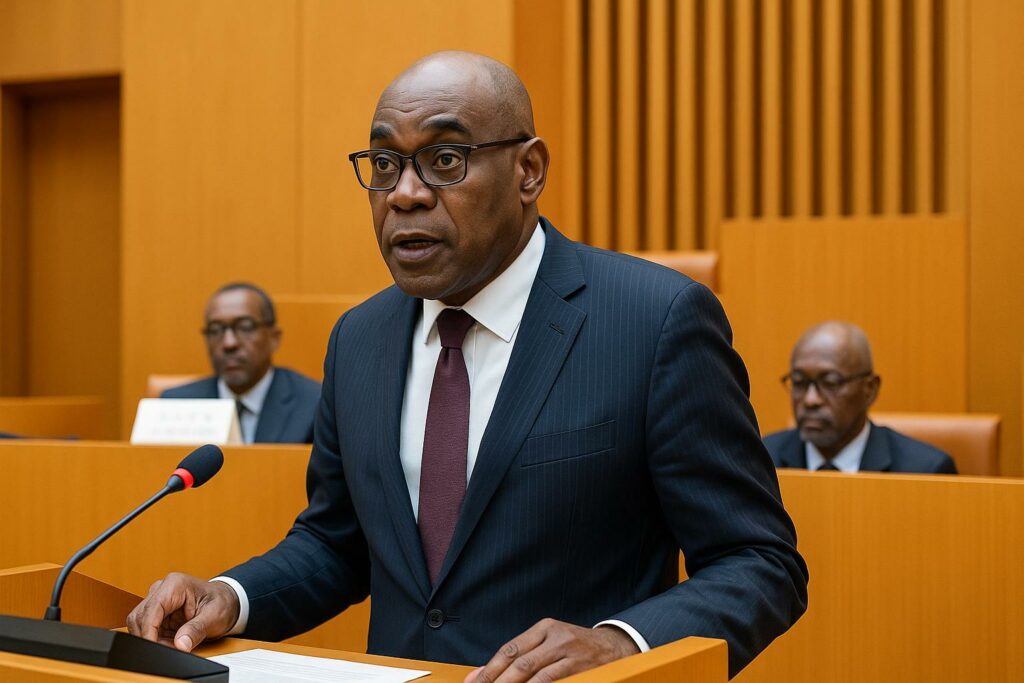A fiscal roadmap anchored in stability
Presenting the 2026-2028 medium-term financial framework to both chambers of Parliament, Finance and Budget Minister Christian Yoka insisted that Brazzaville is “maintaining the course of stability” even as external headwinds persist. The government expects to generate primary surpluses each year of the triennium, resources that will be channelled first to amortise external debt and settle domestic arrears. The ministry’s macro-fiscal scenario assumes average real growth of 3.8 %, inflation contained below the 3 % CEMAC convergence ceiling and a gradual narrowing of the overall deficit to 1 % of GDP by 2028.
Targeted debt reduction and market-friendly signals
According to the latest public debt bulletin, the Republic of the Congo’s debt stock still hovers around 77 % of GDP, above the 70 % regional threshold. The strategy now centres on renegotiating the most expensive market instruments and restricting new short-term treasury borrowing to the strict coverage of amortisation needs. Officials close to the file note that ongoing discussions with bilateral partners and the IMF, whose fourth Policy Coordination Instrument review is expected early in 2026, aim to secure softer repayment profiles without undermining sovereign credibility (IMF country report, May 2024). Moody’s Investors Service welcomed the intent, stating in a recent commentary that “front-loaded primary surpluses improve debt sustainability metrics and signal policy discipline” (Moody’s, June 2025).
Elevating the personal income-tax threshold
The most visible social measure in the draft budget is the sharp increase in the income-tax exemption threshold, a reform inspired by a 2023 CEMAC directive on fiscal equity. Under the new scale the first 240 000 CFA francs of annual earnings will be fully exempt, compared with 120 000 CFA francs today. Ministry estimates suggest that more than 30 % of salaried workers—primarily in the informal segment—will see their tax burden wiped out, which could inject an additional 12 billion CFA francs of purchasing power into local markets during the first year of application. Christian Yoka cautioned that the new schedule will only become operational after a calibration phase devoted to impact studies and IT upgrades, a window he described as “indispensable for safeguarding revenue integrity.”
Corporate taxation and investment climate
While wage earners will wait for the final rollout, firms are slated to feel the reform pulse from 1 January 2026 onward. The corporate income-tax code will be streamlined, erasing a series of sectoral surcharges and recasting depreciation rules to encourage reinvestment. In dialogue with the Congolese private sector federation, the ministry projects a modest, short-term revenue shortfall—offset, it argues, by higher compliance rates and broader taxable bases. Investors interviewed by our newsroom describe the approach as “constructively minimalist”: rather than headline rate cuts, Brazzaville seeks to reduce administrative frictions, a stance consistent with World Bank recommendations in its latest Doing Business update (World Bank, April 2025).
Social cohesion through fiscal engineering
Economists at the University of Marien-Ngouabi underline that the new income-tax threshold could cushion urban households against imported inflation, particularly on food and transport. In a context where 40 % of the working population remains in vulnerable employment, the measure carries symbolic weight, illustrating the government’s stated ambition to weld together fiscal prudence and social responsibility. Parliamentarian Émilienne Itoua, chair of the Finance Committee, summed it up during the debate: “Debt reduction is indispensable, but it must rhyme with dignity for the most modest.”
Monitoring risks and the regional lens
Analysts nonetheless flag several watch-points. Oil revenues, still representing nearly half of public receipts, remain sensitive to price swings and production volumes. Moreover, the pace of domestic arrear clearance will need to be carefully sequenced to avoid liquidity strains within the local banking system. Regionally, Brazzaville’s commitment strengthens CEMAC’s collective effort to restore the buffer stock of the BEAC after the pandemic shock, a stance welcomed by the Bank’s governor Abbas Mahamat Tolli during the June monetary policy committee.
Key economic takeaways
Brazzaville’s 2026 budget blueprint sets a deliberate course: channel every fiscal surplus into debt service, reshape the tax landscape to protect low-income earners and reassure investors through predictable rule-making. If successfully implemented, the package could lower the debt-to-GDP ratio by an estimated six percentage points by 2028 while enlarging the consumption base. The interplay between steadfast execution and resilient commodity receipts will, however, determine whether the plan evolves from prudent ambition to enduring achievement.

